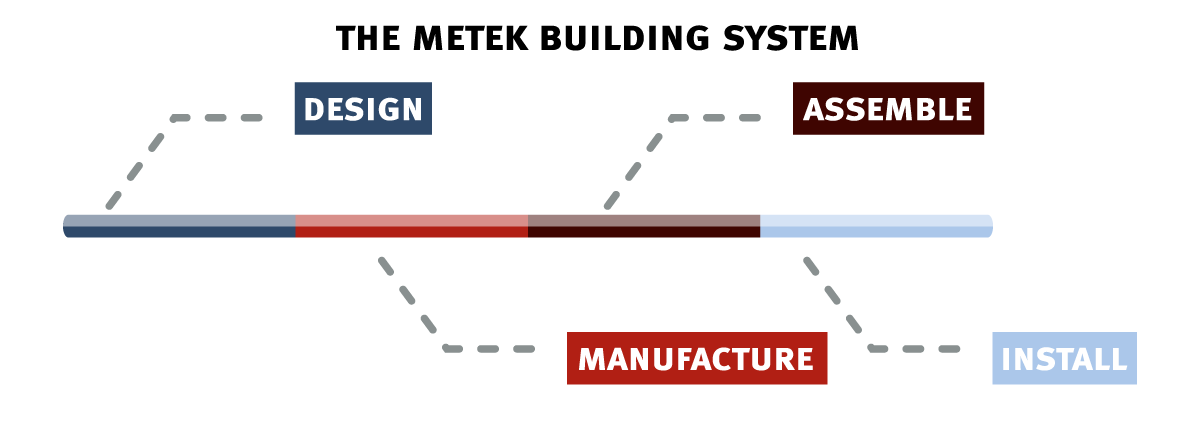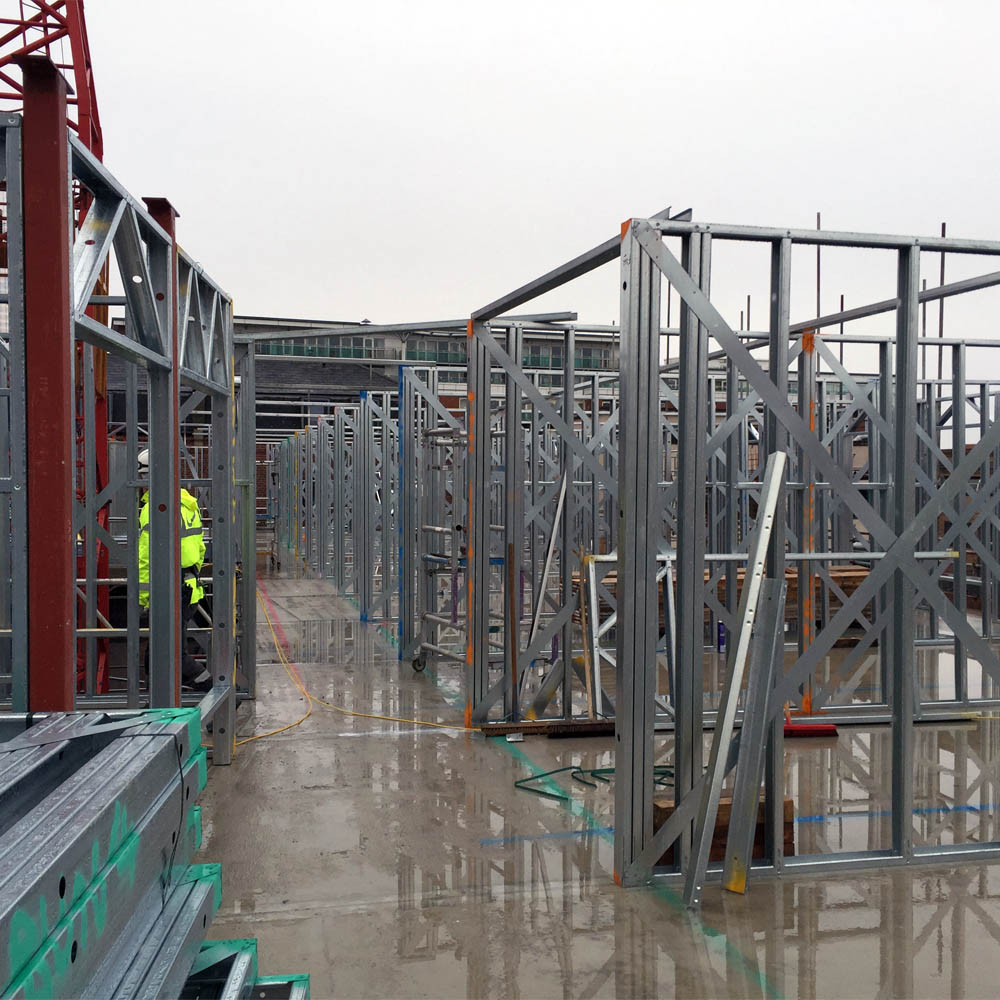Metek was founded by Dr. Alan Rogan who has been at the forefront of light steel framing research for many years. His research and published work have helped promote the use of light steel framing in the construction of buildings.
Metek is an innovative company in light steel framing technology. The Metek System is fast, economical and efficient in design and manufacture. With excellent performance characteristics our design team can tailor the system to suit requirements specific to your project.

Advantages of the Metek Building System
The Metek Building System enables complex wall panels to be manufactured quickly and cost effectively, including curved structures.
Key Benefits
- Lightweight construction
- Off-site manufacture
- Early dry envelope
- Minimum waste from site
- Steel offcuts are recycled
- Minimum disturbance to the locality
- BRE Green Guide A+ or A rating
- ‘Just in time’ deliveries
- ‘Dry’ construction technology
- High levels of airtightness possible
- Ultra low u-values possible for fabric first applications
- Future adaptability

Energy and CO2
The primary use of energy over the building’s life is its operational energy due to heating (and in some cases cooling). Low u-values of less than 0.2 W/m2°C can be achieved by ‘warm frame’ construction in which the majority of the insulation is placed externally to the light steel frame and is supplemented by mineral wool placed between the light steel members.
Steel framed buildings can be designed to be very air-tight, with a leakage rate of less than 2m3/m2/hr, which would otherwise be a source of unwanted heat loss.
The operational energy of a house is 10-15 times more than the embodied energy in its materials over a 50-year design life span. However, light steel framing compares well with concrete or brick/blockwork construction in terms of low embodied energy.
| Components | Materials weight kg/m2 floor area | Material embodied energy MJ/kg | Total embodied energy MJ/m2 | Kg CO2:kg weight of material |
|---|---|---|---|---|
| Light Steel framing | ||||
| Light steel frame | 30 | 22.0 | 660 | 1.34 |
| Plasterboard | 75 | 2.0 | 150 | 0.18 |
| Insulation | 5 | 30.0 | 150 | 1.80 |
| Chipboard | 12 | 35.0 | 420 | 0.40 |
| Total | 122 | 1380 | ||
| Concrete frame | ||||
| Concrete* | 600 | 1.8 | 1080 | 0.14 |
| Reinforcement | 35 | 13.0 | 455 | 0.92 |
| Blockwork | 150 | 1.4 | 210 | 0.20 |
| Plasterboard | 50 | 2.0 | 100 | 0.18 |
| Total | 835 | 1845 | ||
|
* 200 mm flat slab The embodied energy and CO2 data are taken from published sources and include appropriate recycling rates for the various materials. |
||||
The embodied energy of a light steel frame is estimated to be 26% less and the carbon footprint 57% less than that of a concrete frame with blockwork walls (excluding the cladding and finishes which are common to both). Where required for higher-rise applications, a composite floor supporting light steel infill walls is estimated to contain 2% less embodied energy and 24% less in terms of carbon footprint than a concrete frame.
Materials
Light steel framing is by its nature lightweight, and the light steel structure of a medium-rise residential building can weigh less than 20% of that of an equivalent concrete frame, and is even lighter than a timber frame. Other lightweight materials used in this technology include various types of boards and insulation. Savings in foundation sizes can be significant when the low weight of the light steel framework is taken into account, which is very important on ‘brown-field’ sites and poor ground, where concrete in foundations can be reduced by up to 50% relative to brick and blockwork.
Water
The construction technology is essentially ‘dry’ and minimal water is required in manufacture.
Waste
Waste in traditional construction arises from various sources:
- Over-ordering to allow for site variations
- Damage and breakage and losses on site
- Re-work due to errors and inaccuracies
According to BRE, the construction industry average for material wastage on site is 13%.
In comparison, waste is essentially eliminated by light steel framing manufacture and installation. All off-cuts and drill swarfs are fully recycled in the factory and site wastage is recycled. Nationally, 93% of all steel is recycled after use and 50% of current steel manufacture in Europe comes from recycled steel (scrap).
Pollution
Pollution on site is eliminated when using light steel technology, and all steel can be recycled efficiently after dismantling. Transportation of materials to site is reduced by 70% in comparison to brick and block construction, with a consequent reduction in traffic pollution.
Management
Site management is much improved by ‘just in time’ delivery and minimal storage of materials on site. Installation teams are highly skilled and productive. Noise and other sources of disturbance are also minimised, which is important in terms of Considerate Construction.
Site deliveries and site traffic due to construction activities are also reduced relative to more traditional ways of building, based on data in a recent National Audit Office report.
The BIM design model of the light steel framework is available to all members of the design and construction team and can be retained by the client for future records.
Performance Characteristics
Light steel frames are strong and robust to damage. Steel is non-combustible and does not add to the fire load (which is important in relation to its primary competitor, timber framing).
High levels of acoustic isolation and thermal performance can be achieved.
No shrinkage or long term movement occurs, and ‘call backs’ to rectify errors are largely eliminated. The durability of galvanised steel has been assessed in site trials by Tata and SCI and a design life of over 100 years is guaranteed in ‘warm frame’ applications.
Adaptability and End of life
All steel construction is highly adaptable in that attachments and openings can be made relatively easily. Long span lattice joists provide for adaptable space and freedom in servicing. At the end of its life, steel frames can be dismantled easily and re-used or ultimately, recycled (98% of all steel is re-used or recycled).
Social Responsiblity
All Metek’s light steel components are stamped with their project title, date and component number and are traceable to their original source. The galvanised steel that is used has guaranteed high strength properties and has a reliable level of safety and no longterm deterioration. Light steel manufacturing requires a high level of skills and training with excellent job opportunities. It is a safe practice on site.
Carbon Reduction Policy
Metek plc is committed to achieving Net Zero Emissions by 2050. Our current carbon reduction plan in accordance with PPN06/21, can be viewed here
Contact
Metek Plc,Unit 602,
Stonehouse Business Park,
Sperry Way, Stonehouse,
Gloucestershire
GL10 3UT
Telephone: 01453 794 800
Fax: 01453 822 831
Email: estimating@metek.co.uk
Company registration: 4123370
A company registered in England.
Vat registration 762 8833 94